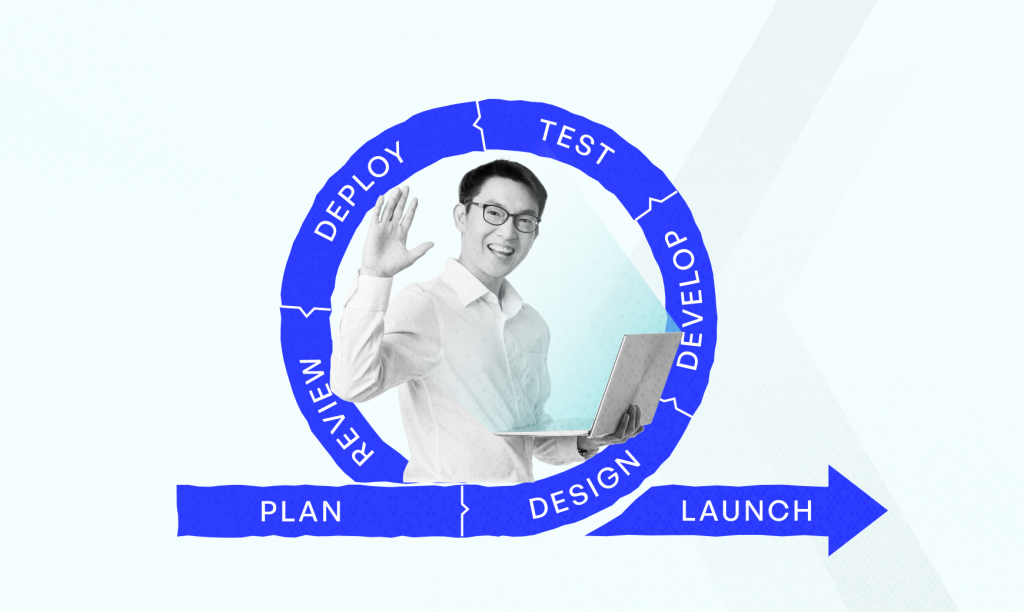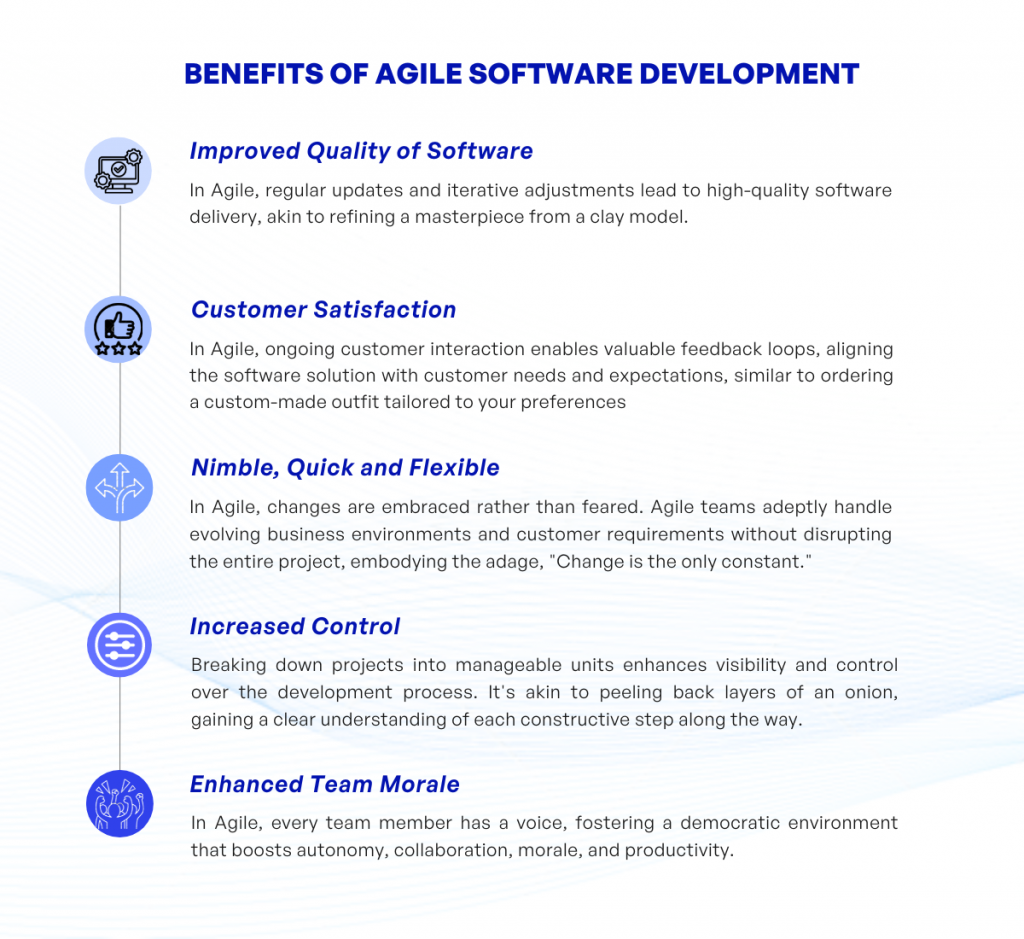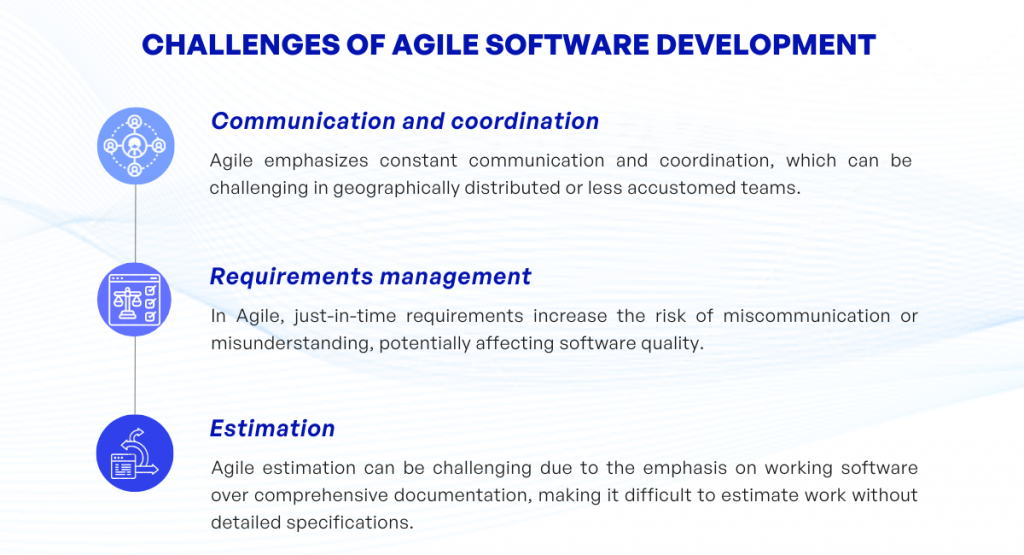
The Agile Approach: Transforming the Software Development Process. Struggling with complex codes and implementation strategies? You’re not alone. A staggering 71% of organizations reportedly utilize the Agile approach for their software development, as per the Project Management Institute. But, why is a software development process a hot buzzword in today’s digital era? Let’s dissect and understand
this popular concept.
Understanding Agile Software Development a.k.a Software Development Process is a methodology centered on the idea of iterative progress, where solutions and requirements evolve through the collaborative effort of cross-functional teams. Sounds complex? Don’t worry, we’ll simplify it for you.
Agile is all about embracing change, improving software quality and speeding up delivery times.
1. Introduction to the Software Development Process
So, you’ve probably heard the term Software Development Process’ being thrown around in tech and business circles. But what exactly is it? To put it simply, Agile software development is an innovative approach to project management and software production. It emphasizes flexibility, collaboration, and customer satisfaction. Unlike traditional methods of software development that value rigidity and strict planning, Agile methodologies value adaptive planning, evolutionary development, and continuous improvement.
The Agile model actually had its roots in the manufacturing sector, inspired by Lean Production systems. However, it was quickly adapted by the software industry in the 1970s and 1980s. The formal definition of Agile didn’t come till much later in 2001 when the Agile Manifesto was created. This document, authored by a collective of software developers, laid out the primary values and principles of Agile that we follow today.
Now, you might be wondering, “How does Agile software development work?” Well, Agile practices involve regular introspection of the development process and then adjusting the process if required. This promotes a high level of adaptability and a rapid response to changes. Imagine you’re building a house. In traditional project management, you would finish the entire house, and then invite the owner to see if they liked it. With Agile, you would build part of the house, let the owner inspect it, take their feedback, and then progress with the next part of the house. That’s the core philosophy of Agile – creating working software and delivering it to the customer for evaluation before moving forward.
But Agile is not just about the software development process. It also touches upon interpersonal aspects. Agile emphasizes a culture of open communication, collaboration, and trust, both within teams and between the team and clients. So in summary, the software development process is about being responsive to changes, constantly improving, and placing the customers’ needs at the forefront. It’s about recognizing the importance of individuals and interactions, valuing customer collaboration, and seeking practical results.
2. Principles of Agile Software Development
If you’re diving into agile development for the first time, you’ll likely encounter a set of 12 principles. These guiding values provide the foundation for Agile methodology, providing a roadmap for teams who want to deliver high-quality software. When properly implemented, these principles create an environment of continuous improvement, fostering a culture that values adaptability, efficiency, and customer satisfaction. Let’s explore them in a bit more depth.
Customer satisfaction: The Agile approach centers around the continuous delivery of valuable software to the customer. The primary aim is to prioritize customer satisfaction and trust. That is achieved by consistently delivering useful software and meeting their needs within timelines.
- Accommodating Change: Agile environments don’t shy away from changes in requirements, even if they’re proposed late in the development cycle. Through the embrace of flexible processes, Agile teams understand that changes can bring about important advancements and more valuable software.
- Deliver Frequently: Agile teams aim to deliver working software frequently, with a preference for shorter timescales. This incremental delivery approach encourages customer feedback for iterative enhancements.
- Collaboration: Agile development encourages regular, face-to-face communication between business stakeholders and development teams. It establishes the fact that effective conversation is the best way to transfer information.
- Motivated individuals: The success of agile development heavily relies on motivated individuals. Agile leaders trust their teams to do the job, providing them with the tools and the environment necessary for getting the job done.
- Direct Communication: It emphasizes face-to-face interaction over written documents when the team is all in the same location.
- Working Software: The measure of progress in an Agile methodology is the delivery of working software, frequent and continuous.
- Sustainable Development: Agile development promotes sustainable development. The sponsors, developers, and users should maintain a constant pace indefinitely.
- Continuous attention to technical excellence: Good design and technical excellence is the essence of Agile. It aims to help teams strive for design and code goodness, enhancing adaptability and flexibility.
- Keep It Simple: “Simplicity–the art of maximizing the amount of work not done– is essential”. Agile methodology underscores the significance of simplicity. One should take on only the work that is necessary, bypassing what is not needed.
- Self-Organizing Teams: Agile methodologies believe the best architectures, requirements, and designs emerge from self-organizing teams. They have the ability to manage and plan for their work.
- Regular Reflection: Teams regularly reflect on what’s working and what’s not, to tune and adjust behavior accordingly. This is done in the form of retrospectives, allowing teams to learn quickly and improve.
Through these principles, the Agile methodology promotes a product-oriented mindset, rather than a project-oriented one. It encourages teams to think in terms of customer satisfaction and product improvement, focusing on delivering continuous value through incremental changes.
3. Benefits of Agile Software Development

You might be wondering, with all its methodologies and principles, what exactly does the software development process offer? Well, it brings a lot to the table! Agile development promotes a flexible and efficient environment that enables progress through individual and collective efforts. Let’s delve right into what makes Agile the practical choice for software development.
3.1 Improved Quality of Software
In an Agile model, regular check-ins and frequent updates mean that issues are identified quickly and corrected continuously. This leads to the delivery of high-quality software. That’s not all; the needed changes are handled iteratively, allowing the team to make adjustments during the development process. It’s like shaping a masterpiece from a clay model, polishing it again and again until it’s just right.
3.2 Customer Satisfaction
With Agile, the customer is always in the picture. The ongoing interaction between the team and the stakeholders provides valuable feedback loops throughout the project. The project vision can be adjusted accordingly, ensuring the software solution precisely matches the customer’s needs and expectations. Let’s say it’s like ordering a custom-made outfit. You express what you need, give suggestions, request adjustments, and, in the end, get what you actually want. That’s satisfying, right?
3.3 Nimble, Quick and Flexible
With Agile, changes are celebrated, not feared. Agile teams can handle changes due to evolving business environments or customer requirements without throwing the entire project off balance. Remember the saying, “Change is the only constant?” That’s the spirit of Agile!
3.4 Increased Control
Breaking down the project into manageable units gives teams much higher visibility and control over the development process. Everyone knows exactly what’s happening; it’s like peeling an onion layer by layer, understanding what’s constructive at each step.
3.5 Enhanced Team Morale
Under an Agile environment, every team member has a voice, contributing to its democratic ethos. The team interacts, collaborates, and takes collective decisions. This autonomy and collaboration boost the team’s morale and productivity. As the saying goes, “United we stand, divided we fall.” That’s Agile for you!
Keep in mind, that the benefits of the Agile software development process can only be fully reaped if it is properly understood and embraced. So it is about getting the ball rolling in the right direction.
4. Challenges of Agile Software Development

Rolling out an Agile approach in your software development process isn’t always a walk in the park. There are potential pitfalls that you’ll need to sidestep. Being aware of these potential blockers can help you to mitigate their impact.
One significant challenge is the cultural shift needed within the team and the wider organization. Agile development doesn’t just require changes in how your team works; it also necessitates a shift in mindset. Every stakeholder must embrace principles such as flexibility, collaboration, adaptability, and trust.
Resistance to change is a common obstacle you might face. Since Agile mandates a departure from traditional methods, resisting elements within a team or organization can slow down or even halt the transition to Agile.
- Communication and coordination: Agile places a premium on constant communication and coordination. This can be challenging in teams that are geographically distributed or if team members are not used to this type of continuous interaction.
- Requirements management: In Agile, requirements are written on a just-in-time basis. Miscommunication or misunderstanding can lead to incorrect or incomplete requirements, impacting the quality of the developed software.
- Estimation: Agile estimation is often a subject of contention. Since Agile emphasizes working software over comprehensive documentation, estimating the amount of work can be difficult without detailed specifications.
Note: Adaptation to the Agile methodology can be a steep learning curve, and having adequate training and support is crucial.
Additionally, implementing Agile in a larger, more structured organization can be a big challenge. It requires significant changes to processes and the distribution of authority. Senior management’s commitment and understanding of Agile concepts and benefits are vital in such situations.
Despite these challenges, with the right strategies in place, the benefits of Agile can substantially outweigh the difficulties faced during the transition period.
Next up, let’s dive into the different Agile methodologies and how they can be applied in your projects.
5. Agile Methodologies
Now, take into consideration the different methodologies or approaches that fall under the umbrella of Agile software development. These give teams the flexibility to adapt the development process to their own unique circumstances and requirements. Various Agile methodologies share a common philosophy, but they implement it in distinctly different ways or use slightly different terminology. Let’s dive into some of the most widely used Agile methodologies.
5.1 Scrum
Scrum, often the go-to Agile methodology, is an iterative and incremental approach to project management and software development. Known for its simplicity, Scrum divides the workflow into Sprints which are time-boxed cycles, typically lasting 2 weeks to a month. Teams work together to create a list of tasks or Product Backlog, before selecting a certain number of these tasks to work on during the next Sprint.
5.2 Kanban
Named after the Japanese term for “visual signal” or “card”, Kanban focuses on managing and improving the flow of work. It visualizes work via a board where each task is represented by a card that moves from one column to the next, representing the stages of the workflow – typically “To Do”, “In Progress”, and “Done”. The goal is to limit ‘work in progress’ to avoid overburdening the team and improve efficiency.
5.3 Extreme Programming (XP)
Highlighting the technical aspect of software development, Extreme Programming (or XP) encourages frequent “releases” in short development cycles. This methodology is intended to improve software quality and responsiveness in the face of changing customer requirements, emphasizing teamwork, customer involvement, and continuous testing throughout.
5.4 Feature Driven Development (FDD)
As the name suggests, feature-driven development focuses on specific features or function units of the software. These features are created using a modeling process and are developed in short iterations, with each feature going through a five-step development process: Develop an overall model, build a feature list, plan by feature, design by feature, and finally, build by feature. While the methods differ, the beauty of Agile lies in its adaptability. These methodologies can often be combined or tweaked according to team needs or project requirements, fostering a productive, efficient, and collaborative environment.
6. Conclusion
As we have discussed throughout this article, Agile Software Development is a unique, iterative approach to project management and software production. This innovative methodology allows teams to self-organize, cross-function, and to adapt rapidly to changes, with the ultimate objective – delivering high-quality software that provides value to users and clients.
From the Principles of Software Development Process to the various methodologies like Scrum, Kanban, XP, and FDD, we’ve explored the backbone that makes Agile the preferred choice for many software development teams today. But just like everything in life, Agile too comes with its Benefits and Challenges.
Among its key benefits, Agile fosters a culture of collaboration, adaptability and continuous learning and improvement. It’s a framework that encourages open lines of communication and a focus on the consumer’s needs. However, it’s worth remembering that the Agile journey also involves its fair share of trials including the need for complete and continual stakeholder engagement, managing team dynamics and the necessary shift in mindset from traditional practices.
To end, it’s important to remember Agile is not a one-size-fits-all solution. It requires commitment, flexibility and an ongoing willingness to deliver results in an ever- evolving environment. Done right, Agile can not only deliver impressive results but can also foster innovation, drive team morale and truly transform the way your team delivers software.
Your journey into Agile may start here, but the lessons you’ll learn and the growth you’ll experience will make a lasting impression far beyond this page. With its guiding principles and popular methodologies, Agile offers a concrete path to delivering software that people love and value.
Remember, Agile is more than just a process or a way to manage a project; it’s a way of viewing the world, a mindset. Embrace it, learn from it, and grow with it – and you’ll find success around every turn.
If you have any questions about Software Development Process, feel free to contact KVY TECH.


